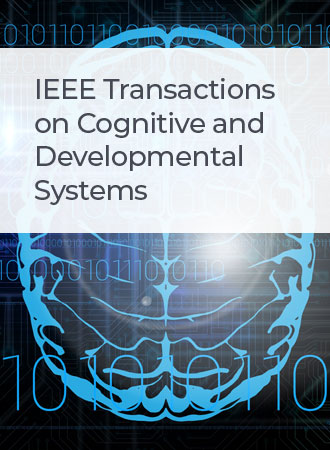儿童期的前脉冲抑制和前刺激非线性脑动力学:一种莱普诺夫指数方法
IF 4.9
3区 计算机科学
Q1 COMPUTER SCIENCE, ARTIFICIAL INTELLIGENCE
IEEE Transactions on Cognitive and Developmental Systems
Pub Date : 2024-06-26
DOI:10.1109/TCDS.2024.3418841
引用次数: 0
摘要
声惊反射(ASR)依赖于感觉运动系统,受年龄、性别和精神病理的影响。ASR可以通过预脉冲抑制(PPI)模式进行调节,即在弱预脉冲刺激后实现对惊人刺激(脉冲)的反应性抑制。此外,神经生理学研究发现,大脑活动的特点是高度复杂的不规则模式,但随着年龄的增长而减少。本研究探讨了健康儿童与成人惊吓前非线性动力学与PPI之间的关系。56个人参加了实验:31名儿童和青少年以及25名成年人。参与者听到51对音调(预脉冲和惊吓),时间差为30到500毫秒。随后,我们通过计算惊前期的最大Lyapunov指数(LLE)来评估神经复杂性,并通过分析惊后事件相关电位(ERPs)来评估PPI。结果显示,与成人相比,儿童的神经复杂性更高,这与先前的研究结果一致,该研究显示,随着年龄的增长,生理信号的复杂性降低了。正如预期的那样,PPI(反映在P50和P200成分中)在成人中比儿童增强,可能是由于前者的ASR成熟。有趣的是,惊吓前复杂性仅在儿童中与P50成分相关,而在成人中没有,这可能是由于年龄组之间感觉运动成熟阶段的不同。总的来说,我们的研究为研究大脑动力学提供了新的贡献,将非线性与线性测量联系起来。我们的研究结果与衰老过程中神经复杂性的丧失是一致的,并表明儿童和成人的非线性和线性指标之间存在不同的联系。本文章由计算机程序翻译,如有差异,请以英文原文为准。
Prepulse Inhibition and Prestimulus Nonlinear Brain Dynamics in Childhood: A Lyapunov Exponent Approach
The acoustic startle reflex (ASR) relies on the sensorimotor system and is affected by aging, sex, and psychopathology. ASR can be modulated by the prepulse inhibition (PPI) paradigm, which achieves the inhibition of reactivity to a startling stimulus (pulse) following a weak prepulse stimulus. Additionally, neurophysiological studies have found that brain activity is characterized by irregular patterns with high complexity, which however reduces with age. Our study investigated the relationship between prestartle nonlinear dynamics and PPI in healthy children versus adults. Fifty-six individuals took part in the experiment: 31 children and adolescents and 25 adults. Participants heard 51 pairs of tones (prepulse and startle) with a time difference of 30 to 500 ms. Subsequently, we assessed neural complexity by computing the largest Lyapunov exponent (LLE) during the prestartle period and assessed PPI by analyzing the poststartle event-related potentials (ERPs). Results showed higher neural complexity for children compared to adults, in line with previous research showing reduced complexity in the physiological signals in aging. As expected, PPI (as reflected in the P50 and P200 components) was enhanced in adults compared to children, potentially due to the maturation of the ASR for the former. Interestingly, prestartle complexity was correlated with the P50 component in children only, but not in adults, potentially due to the different stage of sensorimotor maturation between age groups. Overall, our study offers novel contributions for investigating brain dynamics, linking nonlinear with linear measures. Our findings are consistent with the loss of neural complexity in aging, and suggest differentiated links between nonlinear and linear metrics in children and adults.
求助全文
通过发布文献求助,成功后即可免费获取论文全文。
去求助
来源期刊

IEEE Transactions on Cognitive and Developmental Systems
Computer Science-Software
CiteScore
7.20
自引率
10.00%
发文量
170
期刊介绍:
The IEEE Transactions on Cognitive and Developmental Systems (TCDS) focuses on advances in the study of development and cognition in natural (humans, animals) and artificial (robots, agents) systems. It welcomes contributions from multiple related disciplines including cognitive systems, cognitive robotics, developmental and epigenetic robotics, autonomous and evolutionary robotics, social structures, multi-agent and artificial life systems, computational neuroscience, and developmental psychology. Articles on theoretical, computational, application-oriented, and experimental studies as well as reviews in these areas are considered.
 求助内容:
求助内容: 应助结果提醒方式:
应助结果提醒方式:


